by Marie | Aug 24, 2016 | QuickBooks Compatibility & Industry Types, QuickBooks Essentials, QuickBooks for Mac, QuickBooks for Windows, QuickBooks Online, Resources, Third Party Applications - QuickBooks Compatible
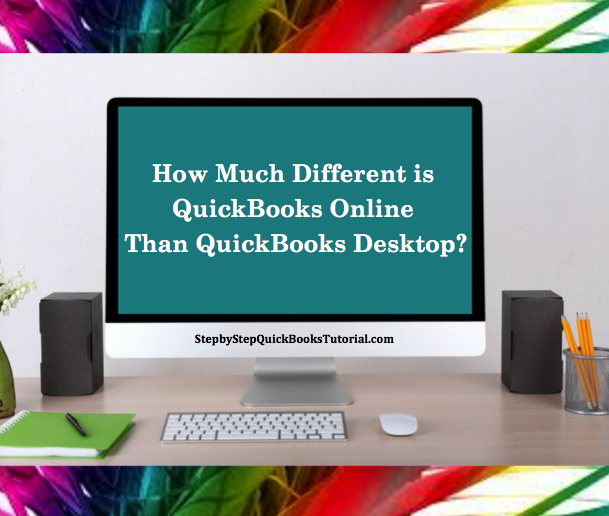
QuickBooks Online interface is very different, and if you are use to the desktop versions, you probably will not like the Online version. It works differently and what can be easily done in the desktop version in a few, usually requires jumping through 2+ hoops in the online version. It is actually more expensive in the long run and clients who have more than one business will definitely find the desktop version more cost effective.
However, according to its maker – Intuit, QuickBooks Online will be the future and so it’s best to get on board sooner than later. Also, I have to say QuickBooks Online has improved greatly within the last three years, and prior to these improvements I was not recommending it at all to my clients.
As with everything else, QuickBooks Online has its advantages as well as disadvantages. The two (2) main advantages of QuickBooks Online being: 1) The ability to access it from anywhere with an internet connection on multiple devices, as well as host multiple users simultaneously. And 2) QuickBooks Online has a ton of third-party applications that can be integrated to make it do much, much more than it already does by itself.
The main disadvantage is that you have to pay a monthly fee which will undoubtedly be increasing over time, and something you will have no control over. Also, if you have multiple businesses, you will need to have a QBO account for each – unlike the desktop version where you could have as many companies in the one version as you like.
The world is becoming more pro “cloud” whether we like it or not, and so it is inevitable that we will need to be a part of that if we want to do any form of business. I say find the positives, and get with it.
by Marie | Apr 25, 2016 | Bookkeeping 101, Company Setup & Management, Invoicing & Receivables, QuickBooks for Mac, QuickBooks for Windows, QuickBooks Online, Reimbursements and Investments

The most common cause of this problem is that some items are using COGS for the income account. If you have invoices with items that have a COGS account as their income account, this will definitely cause a negative Cost of Goods Sold. Review the invoices hitting COGS and see which actual items are involved and then change the items in the item list. You have more credits than you do debits and those credits are coming from invoices hitting Cost of Goods Sold. COGS should be a debit with no invoices in the detail. You need to look at the invoices that are hitting COGS and see which exact line item it is. That is the item that has the incorrect account for income. That said, there a few other things that can cause the COGS to be negative.
Few things that can cause the COGS to be negative:
- Using an item on the invoice that has a COGS account as the income account
- Using an inventory item on a credit memo
- Using the COGS account as a credit on a journal entry
- Using the COGS account on a deposit
To fix the negative Cost of Goods Sold problem:
To locate and correct this issue, you need to start by generating a detail transaction report of your Cost of Goods Sold account(s). Once you have done that, double-click on all the negative transactions to see what exactly is causing the problem. You can also select the Reports button at the top of the transaction (not the top-level menu) and then select Transaction Journal. You can press Ctrl Y while the transaction is open to see what the underlying journal is.
You are looking for amounts in the Credit column for the COGS account – debits increase it, credits decrease it. If you are using items, inventory and other functionalities of QuickBooks, the direct problem could be one or more bills, checks, credit card charges, Invoices, credit memos, journal entries, or deposits. This report will show you exactly what is causing it.
In addition, you need to make sure that reimbursable expense is an Income account if you have reimbursables, and also ensure that the option is checked in the Preferences to track reimbursable expenses by going to Edit, Preferences, Time & Expenses, Company Preferences and make sure “Track reimbursed expenses as income” is checked.
Similar Articles:
by Marie | Mar 26, 2016 | Bookkeeping 101, Business Types & Accounting, Chart of Accounts Setup & Management, Personal and Business Expenses, QuickBooks for Mac, QuickBooks for Windows, QuickBooks Online, Reimbursements and Investments

The way in which these startup expenses are entered will depend on how the owner wants to treat them – loan or investment, the way the business is structured – Sole Proprietor or Single Member LLC, Partnership or Multi Member LLC, or Corporation, as well as when these expenses were incurred.
What are Startup Expenses or Costs?
Before we get into the above, let’s start off with the main question: What are startup expenses or costs? Not everything is a startup cost and to determine what is and isn’t a startup cost we have to look at whether the costs were incurred prior to the start date of the business (costs to be amortized) or subsequent to the start date of the business (costs to be expensed). Startup costs are those expenses that were incurred prior to the start date of the business, and are amortized over a number of years so they are not a total expense in the first year. Initial costs – market research, advertising the future opening of your business, salaries for training employees before the business opened, incorporation costs, trademarks and the likes are startup costs.
As for amortization, that’s just a fancy accounting term accountants like to use when they refer to the process of spreading costs out to more than one year. They are usually intangible costs like legal fees, government filing fees and the likes. Fortunately, amortization is generally a straight-line process; you take the costs and divide them by the number of years and expense by that portion. It is always important to consult a CPA prior to booking startup costs.
If there are technology equipment such as computers or furniture in the initial purchases, you will need to separate them if they are used in the business, since they will need to be depreciated. Depreciation is generally for tangible items such as buildings, equipment, computers, furniture, vehicles, etc. Again, speak with your CPA about what was purchased in order to have all the startups entered accurately, as well as to get the help in setting up a depreciation schedule. For tax purposes, the IRS has specified fixed asset lifespan depending on what kind of fixed assets they are.
Journal entries are the best method to use when entering startup costs, regardless of the type of startup, the type of business structure, or whether the startup is a loan or an investment to the business. You will create an “Other Asset” account under which you can make sub accounts where you will be debiting the transactions, and an equity or loan account where you will be crediting them – depending on if the owner is investing or lending the monies to the company – respectively.
If some of these startup expenses are fixed assets, you will need to create individual Fixed Asset accounts for each, with the corresponding entry going to the Equity or Loan account. If there are multiple small transactions to be entered, you can enter them via the asset account register or the Equity or Loan account register you created. This way you will be able to enter as much information as possible including the dates of each transaction.
Whatever you do, just make sure that you get the correct equity balance to start off with; that is, how much did the owner(s) put in the business to start the business? In taxes, the equity accounts will be used to track the owner’s basis, which is adjusted up for income, owner’s contributions and other items, and down for losses, draws, and other items. Depending on the type of structure – sole proprietorship, LLC, partnership, C-corporation, S-Corporation, business losses may or may not be deductible for tax purposes if the owner does not have enough basis to deduct them against.
You should also speak with your CPA about whether it is better to consider these startup costs a contribution by the owner to the business, or a loan to the business to be paid back at some point in the future, as it relates to taxes.
Another way to enter these initial expenses on QuickBooks for a Sole Proprietor or Single Member LLC, is by using a Credit Card Account called something like “Owed to owner” and entering the expenses from there. This will increase the liability balance while allocating the expenses to their relevant business expense account. If the business pays it back, use the credit card account on the check which will zero out the credit card account. If it does not pay the monies back, use a journal entry to transfer it to the owner’s contribution account. Of course, this is based on what the initial startup costs are.
This is an option used by many QuickBooks users, and although it will make the accounts “accurate”, I do not recommend it from an accounting standpoint. Bookkeeping should be seamless and trackable! Just imagine that someone takes over the bookkeeping and trying to figure out the books, they will no doubt be looking for a business credit card since one would have been entered. For this reason I do not recommend using this method. Why add a credit card to the business in QuickBooks when there isn’t actually one for the business?
Similar Articles:
by Marie | Mar 26, 2016 | Banking Setup & Management, Bookkeeping 101, Deposits & Undeposited Funds, Invoicing & Receivables, QuickBooks for Mac, QuickBooks for Windows, QuickBooks Online, Reconciliations
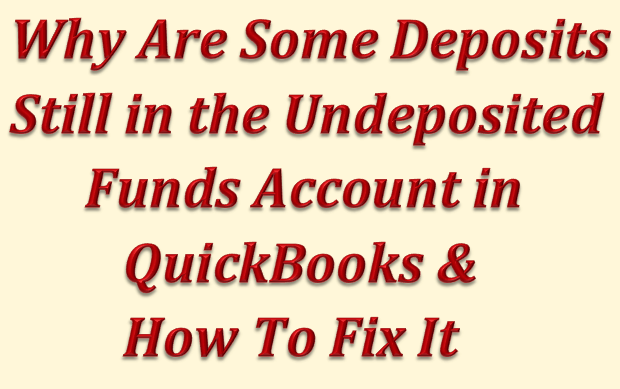
In order to use the undeposited funds correctly, it is important to understand how it really works. What are undeposited funds? Think of the Undeposited Funds account as an envelope where you keep checks until you take them to the bank. If you deposit more than one check or payment in a group deposit, you can enter those transactions so that your Bank Register matches your Bank’s monthly statement.
How to Accurately Use the Undeposited Funds Feature in QuickBooks
To use the undeposited funds accurately:
- When you record each customer payment, choose Group with other undeposited funds instead of Deposit to a Bank account.
- When you have all the checks entered and you are ready to actually deposit them in your bank, use Bank Deposits which is found under the Plus Sign Icon at the top of QuickBooks Online. In the desktop versions, go to Banking in the menu bar, and select Make Deposits.
- In the Bank Deposits or Make Deposit screen, click the drop-down to select the bank account you would like to deposit the funds to. This would of course be the bank account that you actually put the money in.
- Select the appropriate Date, and class or location if you are using them.
- You will see a Payments section. These payments listed are the ones you recorded and marked to go to undeposited funds. You can now select which of these payments should be included in this deposit to reflect the lumpsum deposit that was actually made to the bank.
- Click Save.
In order for this process to be successful, you must remember to go to the Bank Deposits window (in QuickBooks Online) or the Make Deposit window (in the desktop versions – Pro, Premier), and deposit the monies to the bank register in QuickBooks. Otherwise, they will just sit there, and if someone else is doing the reconciliations at the end on the month, they may actually enter those payments again directly to the bank register without realizing or even knowing that they were already in the Undeposited Funds account.
As you can see, there are still deposits in your undeposited funds account because the proper procedure was not followed. If the accounts were already reconciled for the period in which the transactions in the undeposited funds account relates, then the entries were entered twice – incorrectly increasing the revenue and may require an amended tax return to be filed if the tax for that period was already done.
I have explained indepth how to correct this in my articles:
by Marie | Mar 26, 2016 | Banking Setup & Management, Bookkeeping 101, Deposits & Undeposited Funds, Invoicing & Receivables, QuickBooks for Mac, QuickBooks for Windows, QuickBooks Online, Reconciliations

The main purpose of the undeposited funds feature in QuickBooks, is to give users the option of receiving customer payments and applying them to their Invoices on the dates received, while having a place to house them until they are ready to be deposited to the actual bank account. This is called “grouping deposits” in QuickBooks to reflect the lumpsum deposit that was made on a particular date. The undeposited funds feature can be a huge time saver, especially when it comes to reconciling bank accounts. You should absolutely use the undeposited funds feature:
- If you do not deposit each payment received from customers individually. If each deposit is done separately at the bank such as payments received from PayPal, Square, Shopify etc., there is no need to use the undeposited funds feature. If you receive customer payments via check or cash and you combine them to make one deposit into your bank account, then you need to post the individual payments to undeposited funds first. You will later go to Make Deposits and select the customer payments that made up the total deposits that were actually deposited on a specific date. You will need to ensure you change the date for the deposit in the “Make Deposit” window to reflect the date the deposits actually went into the bank. So, you use the undeposited funds when more than one payment is included in a deposit. That way the deposit in QuickBooks matches the deposit on your bank statement which will make it easier when it’s time to reconcile the bank account.
If you do not use the undeposited funds, then the amount is recorded directly in the check register. So, if you actually deposited several checks at once, you can imagine what a nightmare it becomes when you try to reconcile the checkbook. It creates lots of extra work – needlessly. If you use undeposited funds, then you “make deposits” that match the deposits you sent to the bank, which makes life much easier!
- When checks are received and not immediately deposited in the bank. This way, you will know the day the checks arrived and the day they were deposited. Using the undeposited funds feature in this case, will allow you to record the customer payments for the date in which they were received, and thus show accurate customer receivables while at the same time being able to deposit them on the date they were actually deposited. Without using the undeposited funds, it may be difficult to figure out what payments in QuickBooks make up what deposits on the bank statement when it’s time to reconcile the bank account.
When all is said and done, it is better to use the undeposited funds feature for all deposits, than to not use it for any deposits at all – especially deposits of more than one customer payments. You will have a more seamless, less time-consuming reconciliation process which is super important.
How to clear undeposited funds that were entered in error
If “in error” you mean that the transactions were to be sent directly to the bank account register instead of the undeposited funds account, then you can correct this either by: a) locating and editing the individual payments in question and changing the “Deposit to” field to the bank account. Or, b) you can deposit each payment in the “Make Deposit” window to the bank account by checking each one and changing the date to reflect the date it was actually deposited.
If “in error” you mean that the deposits were doubly entered; once directly in the bank via the check register, and again in the undeposited funds account, the cleanest, but also most time-consuming way to clear these items from the undeposited funds account or “Make Deposit” window is to open the corresponding deposits that were made without selecting from undeposited funds, click on the green Payments button, add the payment from undeposited funds, and then delete the incorrect payment that was entered. As long as the total deposit is unchanged, it will not unreconcile the previous reconciliations. However, if there are a lot of transactions in the undeposited funds account, it could take a really long time trying to resolve this. Why can’t I just delete them? You may ask. It is never okay to just delete anything from QuickBooks without knowing what other accounts and transactions may be affected. These customer payments in the undeposited funds account or make deposit window, may have been applied to Invoices. Deleting them will throw the accounts receivables out of balance, leaving the customers owing more in QuickBooks than they actually do in reality.
Bear in mind that most people who bypass undeposited funds use a revenue account to make the deposits, which means the revenue is possibly overstated – if those deposits are again applied to Invoices and are sitting in the undeposited funds account. So if you are trying to correct a period that you have already filed tax returns for, you will need to discuss this with your tax professional. You may need to file an amended tax return.
by Marie | Mar 26, 2016 | Banking Setup & Management, Bookkeeping 101, QuickBooks for Mac, QuickBooks for Windows, QuickBooks Online, Reconciliations
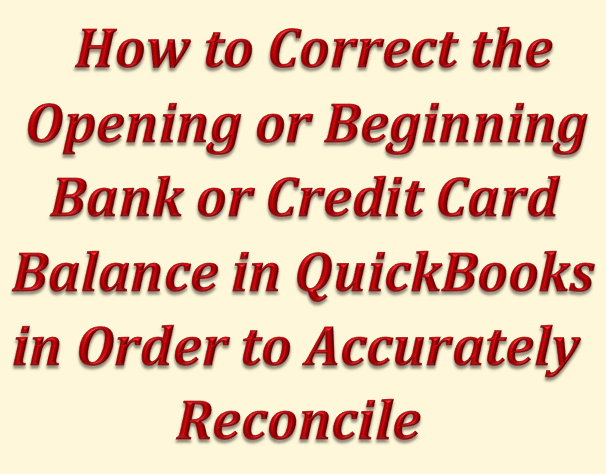
The way in which you handle a beginning balance that does not match your statement depends on whether or not the account has ever been reconciled in the past. If it has never been reconciled, you can change the opening balance by following these steps:
- Go to List in the menu bar and click Chart of Accounts.
- Double-click the account in question to open to the register.
- Locate the account’s opening balance transaction which is usually the first transaction in the register or look for the Opening Balance Equity in the Account field of the register.
- Change the amount to the correct opening balance that is on the bank or credit card statement.
- Click Record.
You may have entered your opening balance incorrectly. An opening balance transaction is created when you create a new account. You may have added a bank account during the EasyStep Interview, or you may have created a bank or credit card account at any time after the interview. Following the abovementioned steps will get your opening bank balance in Quickbooks on par with your bank account balance for that period.
If the account has previously been reconciled – at least once, and the opening balance was ok then, you need to locate the discrepancy. In this case, you cannot just change the beginning balance; you need to find out why the beginning balances are different. Some reasons that may cause the discrepancy are:
- You may have uncleared a transaction directly in the account register by mistake. If you do this, your beginning balance will be off by that amount. You will be able to see this in the Reconciliation Discrepancy report if one is available in your version and edition of QuickBooks. Otherwise, you could run a report to view the transactions that are unreconciled for that period, and try to locate them on the statements. Hopefully, there aren’t many unreconciled transactions for that account in the period in question.
or
- You have changed or deleted a previously cleared transaction that you have already reconciled. To fix this, you will need to undo the previous reconciliation, then reconcile again with the correct transactions. If the option is available to undo the previous reconciliation in the reconcile window, then undo all the previous reconciliations to the date where both the bank or credit card statement and the QuickBooks beginning balances are the same. If the undo previous reconciliations option is not available in that version and edition of QuickBooks, you will need to go to the Bank or credit card account register and uncheck the transactions one by one.
by Marie | Mar 25, 2016 | Bookkeeping 101, Customer Setup & Management, Invoicing & Receivables, QuickBooks for Mac, QuickBooks for Windows, QuickBooks Online
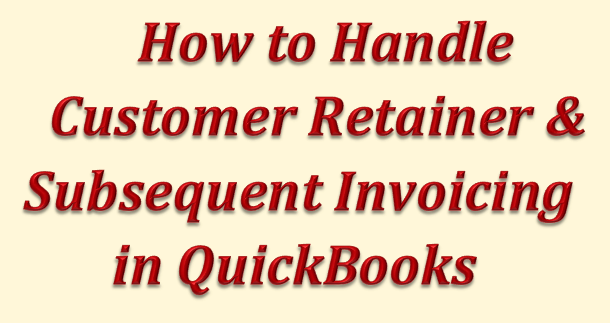
There are two types of retainer fees: one type is used as a downpayment where a customer or client pays a lawyer an amount, for example, and when the lawyer does work for the client he Invoices for that portion and offsets the Invoice total against the downpayment. The Invoice portions for work done are recorded as Income, with the corresponding total going to the retainer liability account decreasing the customer retainer balance. At the end of the year, depending on the agreement both party has, the retainer balance will either be returned to the customer or forward to the new year.
The other type of retainer is when a customer or client pays a company an amount of money for a period of time – say one year, so that they can have the privilege of using their service(s) during that period. This type of retainer in non-refundable, whether the client uses the service(s) or not, for this period. At the end of the period – usually a year, the retainer should be moved from the liability account to an Income account. This can be done via a journal entry by debiting the retainer liability account and crediting the Income account.
There are usually more than one ways to do things in QuickBooks, but this is the best option to handle customer retainer and subsequent invoicing in QuickBooks, and it can be used for both scenarios above:
- Create a Liability Account called something like “Retainer Liability” using a current liability account.
- Next, create an item called something like “Retainer” and map it to the retainer liability account you previously created.
- Use that item on the invoice or sales receipt for the retainer transactions. This will increase the retainer balance.
- After the work is performed, create an invoice or sales receipt like you normally would, with the appropriate sales items. Then add a line with a negative amount using the retainer item. This will increase sales Income and decrease the retainers account, as well as reduce the Invoice or sales receipt down to the remainder due.
Reconciling the Retainer Account
To reconcile the retainer account each month, go to your Chart of Accounts and reconcile your Retainers as you would a credit card or bank account. There is only one difference; enter your statement balance for the end of the month as ZERO. Then check off all the retainers that were charged and used up. The total of the checked items should equal zero, and the total amount owing should consist of all the unchecked items.
by Marie | Mar 24, 2016 | Bookkeeping 101, Business Types & Accounting, Personal and Business Expenses, QuickBooks for Mac, QuickBooks for Windows, QuickBooks Online, Reimbursements and Investments

As a business owner myself, I know that it is unavoidable at times – mixing business with personal funds, but this is not good business practice and should be avoided as much as possible. Why? Because, it is very easy to overlook business expenses that are paid with personal funds, and it is the best way to have IRS auditors going through all your personal affairs even though an issue is a business one. Since those monies do not directly affect the business bank or credit card accounts, you will need to make a concerted effort to track those expenses and record them appropriately on the business books.
Entering business expenses paid for with personal credit card or cash on the business books will depend on the structure of the business:
- For a Sole Proprietor or Single-Member LLC, the expenses should be entered to the relevant expense categories via Owner’s Draw/Equity. You will use this account for monies going in and out of the business by the owner. The Owner’s Draw/Equity accounts may have negative balances from time to time which will look odd on the balance sheet. So, it’s important to prepare a journal entry zero-ing out or offsetting these balances at the end of each month, quarter, or year.
- For a Partnershp or Multi-Member LLC, the expenses should be entered via Member Contribution if the owner is investing it, or loan based on the partnership’s operating agreement.
- For a Corporation, the expenses should be entered as loan if the owner will need to recoup the funds, or Equity Contribution if the owner wants to invest it in the business. If they are to be entered as loan, you will need to make the loan official, with repayment terms, interest, etc. Also, bear in mind that the IRS sometimes re-characterizes loan repayments as dividends – with serious tax implications. In this regard, a CPA should be consulted before deciding how to book these monies in QuickBooks.
In addition to the above mentioned effects of mixing business and personal funds, the mixing of business and personal funds can also pierce the corporate veil, and expose corporate business owners to personal liability which defeats the purpose of having a corporation to begin with. Sole proprietors already have personal liability, but not a corporation as it is an individual entity in itself. Separate business and personal financials at all cost, but if you do not, remember to enter them in their appropriate places and keep a record of receipts in the business files.
by Marie | Mar 20, 2016 | Importing Files & Forms To QuickBooks, QuickBooks for Mac, QuickBooks for Windows, QuickBooks Online, Reconciliations, Third Party Applications - QuickBooks Compatible

Reconciling Paypal account in QuickBooks is similar to reconciling a bank or credit card account in QuickBooks. You want to ensure that your beginning balance in QuickBooks matches the beginning balance for the period you are reconciling, and subsequently selecting the period end date then checking off the transactions that are on Paypal transaction printout with its corresponding transaction in QuickBooks.
Manually Entering or Downloading Transactions in QuickBooks Prior to Reconciliation
Depending on the number of transactions you have in Paypal and how you want to track them, will be the deciding factor on the method you use. I have a few clients that need each Paypal transaction to be entered individually because each transaction can be for something different. In this case, I have to produce a Sales Receipt for each one and apply the money to the correct item. I then make a deposit using the Undeposited Funds account just like I would any other deposits.
The one difference is that when you have selected all the items that you are depositing you then need to subtract the total Paypal fees. These should not be subtracted from each person/entity you received funds from because you need to show that you received the full amount of the money. Therefore, on the Make Deposit screen I use the next available empty row to add the Paypal fees. If you have an account that you are using specifically for tracking these, then that account will be used in the From Account column.
In the Memo field you can enter Paypal Fees if you would like, and you can insert “PP” for Paypal in the “Payment Method” field. The key to this working is when you enter the cost for the fees in the “Amount” column, they need to be entered as negative numbers. The total deposit should equal the amount that was transferred from PayPal into your bank account. This way the full cost of whatever was purchased will show in their proper accounts and the proper Expense account will be increased by the Paypal Fees.
If you usually have a lot of transactions for Paypal, you may choose to use Simple Port to import your Paypal transactions to QuickBooks. Once you have set the PayPal download to the correct format you will never have to do it again, and when it is configured correctly, Simple Port imports each transaction as a sales receipt, makes the deposit, and records the PayPal fees. The setup process can be a bit daunting, but they do offer free phone help and support and once they are through, your settings will be perfect and you won’t need to change them again. It has helped me tremendously with clients that have hundreds of Paypal transactions to contend with. Within 30 minutes, I usually get about 600 PayPal transactions into QuickBooks if I have to separate by sales tax jurisdiction, and less than 10 minutes if sales tax is not an issue.
Reconciling Paypal Account With QuickBooks
Now, all you have to do is go to Banking, Reconcile, select the Paypal Account from the dropdown menu, insert the period end date, ending balance and click Ok. Check off each transaction on the statement with its corresponding transaction in QuickBooks. When you are through, the difference at the bottom of the reconcile window should be $0.00. If it is not, then you will need to locate the discrepancy. If you do not see the transactions in QuickBooks, even though they are on the Paypal printout, you will need to manually enter them.
Conversely, if there are transactions in QuickBooks for the period you are reconciling but not on the Paypal printout, you will need to query them and delete or transfer them to the account for which they belong. This can sometimes occur when the download/import is not the option used to enter transactions in QuickBooks.
Note: To get the Paypal report that includes Paypal fees as well as a running balance, go to Activity, Activity (including balance & fees), and run a report for the period.
 How to Download Paypal Transactions to QuickBooks
How to Download Paypal Transactions to QuickBooks
by Marie | Mar 20, 2016 | Bookkeeping 101, Chart of Accounts Setup & Management, Financial Statements & Reports, QuickBooks for Mac, QuickBooks for Windows, QuickBooks Online
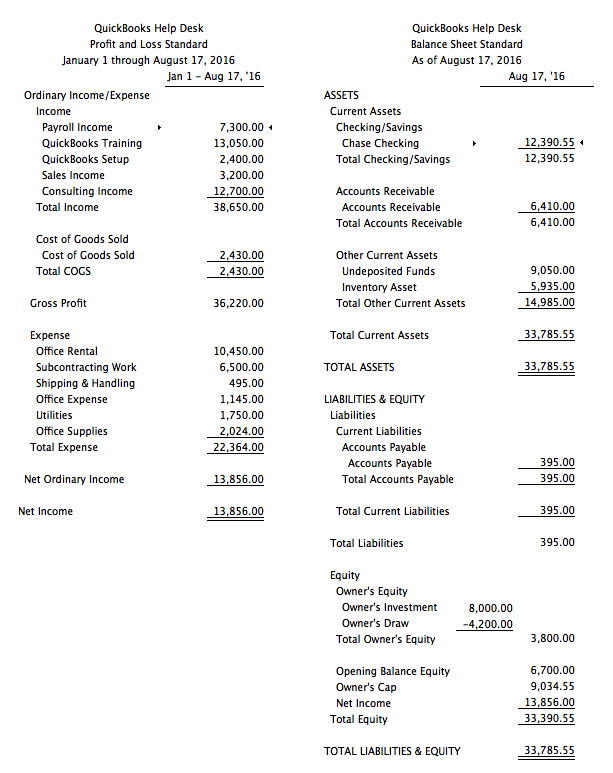
Your Profit and Loss Report is not showing Owner’s Draw because Owner’s Draw does not belong on a Profit & Loss Report and should not be there. Owner’s draws are not expenses so they do not belong on the Profit & Loss report. They are equity transactions shown at the bottom of the Balance Sheet.
The fact that you are asking this question, tells me that you do not have basic accounting knowledge, and you should not be doing any form of bookkeeping or accounting without this basic knowledge. You need basic understanding of a Chart of Accounts and how certain accounts feed to either a Balance Sheet or Profit & Loss report. Balance Sheet accounts, such as bank account, loan, and equity fluctuate as time goes on and a Balance Sheet is a snapshot of the balances in the accounts on the day requested. Income and Expense accounts accumulate figures and usually increase until closed out at year end, and the cycle starts again for each new year. That is why a Profit and Loss asks for a date range or period, while the Balance Sheet uses an “as at” date.
Profit & Loss Reports show:
- Revenue or Gross Sales
- Expenditures
- the resulting Profit or Loss
Balance Sheet Reports show:
- Assets
- Liabilities
- Equity
Regardless of the software – QuickBooks or others, none will make sense until you understand how the puzzle works and the unique ways certain kinds of companies must flow. If you do not know what you are doing, you could end up making a huge mess that will be very costly to clean up and reconcile. There are many bookkeeping and accounting classes out there, and it will be well worth your while to take a basic accounting course at your local community college. If you are a bookkeeper for a company, your employer may be willing to pay for this class since it will be a direct benefit to his/her business.
Also, since you are using the term “Owner Draw”, it tells me that the entity is a Sole Proprietorship. If the entity is not a Sole Proprietor, you should not be using an Owner’s Draw account. These are things that you will learn in a basic accounting class.
Key Differences Between Balance Sheet and Profit & Loss Account
- The Balance Sheet is prepared at a particular date, usually the end of financial year, while the Profit and Loss account is prepared for a particular period.
- The Balance Sheet reveals the entity’s financial position, whereas the Profit and Loss account discloses the entity’s financial performance.
- A balance Sheet gives an overview on assets, equity and liabilities of the company, but the Profit and Loss account is a depiction of entity’s revenue and expenses.
- The major difference between the two entities is that the Balance Sheet is a statement while the Profit and Loss account is an account.
- The Balance sheet is prepared on the basis of the balances transferred from the Profit and Loss account.












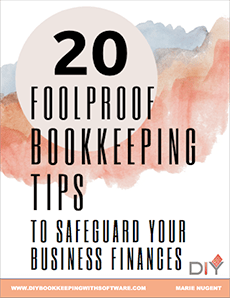
Recent Comments